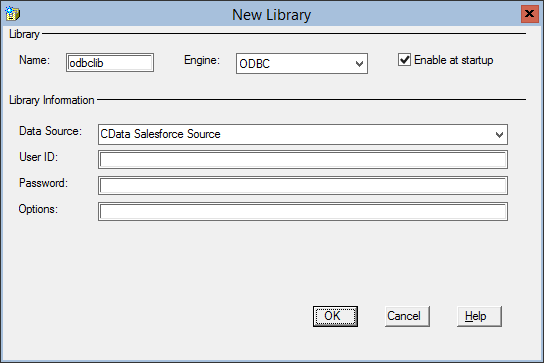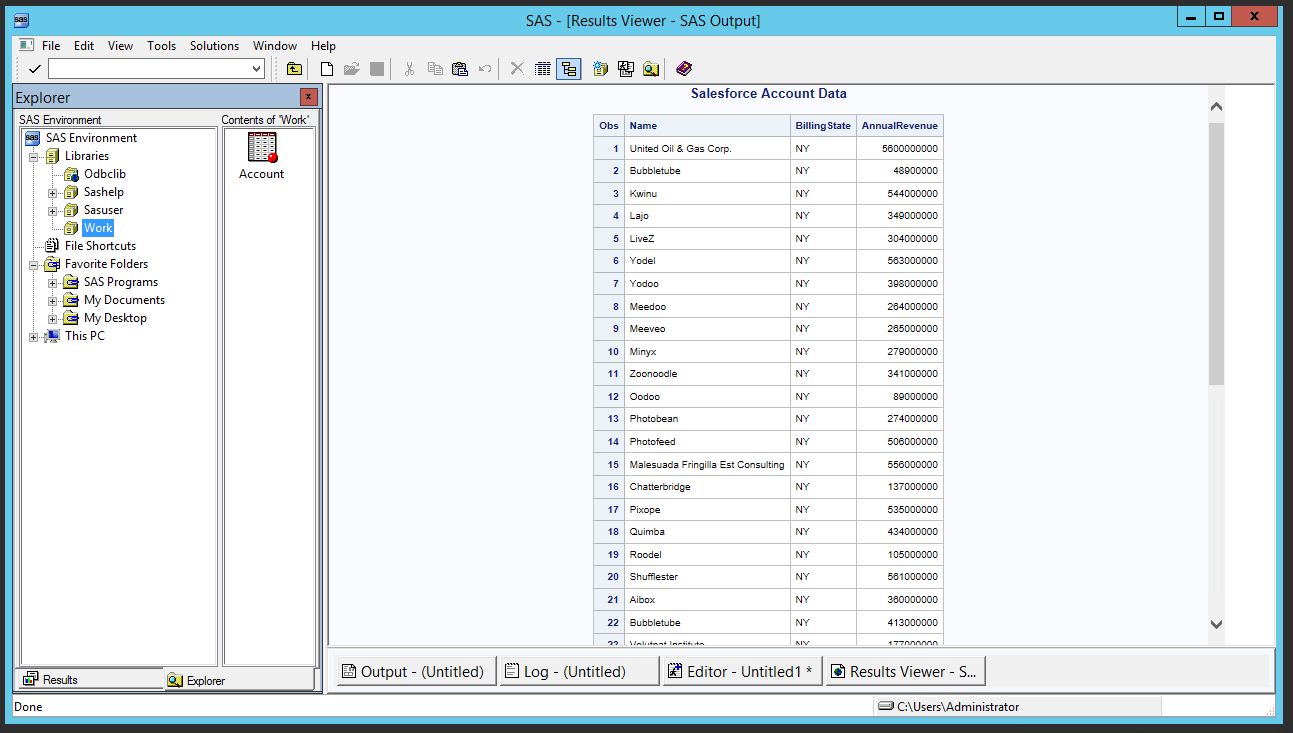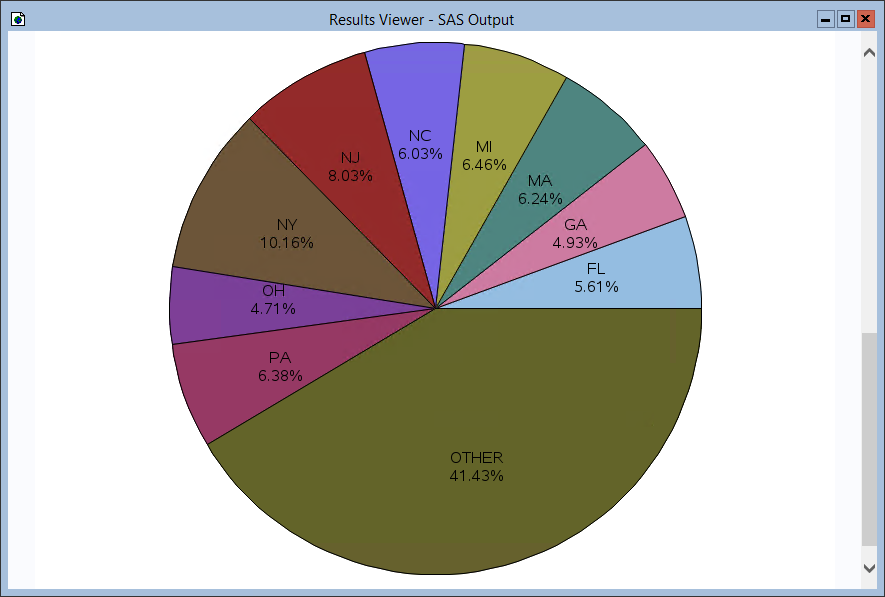Discover how a bimodal integration strategy can address the major data management challenges facing your organization today.
Get the Report →Use the CData ODBC Driver for Bitbucket in SAS for Real-Time Reporting and Analytics
Connect to real-time Bitbucket data in SAS for reporting, analytics, and visualizations using the CData ODBC Driver for Bitbucket.
SAS is a software suite developed for advanced analytics, multivariate analysis, business intelligence, data management, and predictive analytics. When you pair SAS with the CData ODBC Driver for Bitbucket, you gain database-like access to live Bitbucket data from SAS, expanding your reporting and analytics capabilities. This articles walks through creating a library for Bitbucket in SAS and creating a simple report based on real-time Bitbucket data.
The CData ODBC Driver offers unmatched performance for interacting with live Bitbucket data in SAS due to optimized data processing built into the driver. When you issue complex SQL queries from SAS to Bitbucket, the driver pushes supported SQL operations, like filters and aggregations, directly to Bitbucket and utilizes the embedded SQL engine to process unsupported operations (often SQL functions and JOIN operations) client-side. With built-in dynamic metadata querying, you can easily visualize and analyze Bitbucket data in SAS.
Connect to Bitbucket as an ODBC Data Source
Information for connecting to Bitbucket follows, along with different instructions for configuring a DSN in Windows and Linux environments (the ODBC Driver for Bitbucket must be installed on the machine hosting the SAS System).
For most queries, you must set the Workspace. The only exception to this is the Workspaces table, which does not require this property to be set, as querying it provides a list of workspace slugs that can be used to set Workspace. To query this table, you must set Schema to 'Information' and execute the query SELECT * FROM Workspaces>.
Setting Schema to 'Information' displays general information. To connect to Bitbucket, set these parameters:
- Schema: To show general information about a workspace, such as its users, repositories, and projects, set this to Information. Otherwise, set this to the schema of the repository or project you are querying. To get a full set of available schemas, query the sys_schemas table.
- Workspace: Required if you are not querying the Workspaces table. This property is not required for querying the Workspaces table, as that query only returns a list of workspace slugs that can be used to set Workspace.
Authenticating to Bitbucket
Bitbucket supports OAuth authentication only. To enable this authentication from all OAuth flows, you must create a custom OAuth application, and set AuthScheme to OAuth.
Be sure to review the Help documentation for the required connection properties for you specific authentication needs (desktop applications, web applications, and headless machines).
Creating a custom OAuth application
From your Bitbucket account:
- Go to Settings (the gear icon) and select Workspace Settings.
- In the Apps and Features section, select OAuth Consumers.
- Click Add Consumer.
- Enter a name and description for your custom application.
- Set the callback URL:
- For desktop applications and headless machines, use http://localhost:33333 or another port number of your choice. The URI you set here becomes the CallbackURL property.
- For web applications, set the callback URL to a trusted redirect URL. This URL is the web location the user returns to with the token that verifies that your application has been granted access.
- If you plan to use client credentials to authenticate, you must select This is a private consumer. In the driver, you must set AuthScheme to client.
- Select which permissions to give your OAuth application. These determine what data you can read and write with it.
- To save the new custom application, click Save.
- After the application has been saved, you can select it to view its settings. The application's Key and Secret are displayed. Record these for future use. You will use the Key to set the OAuthClientId and the Secret to set the OAuthClientSecret.
When you configure the DSN, you may also want to set the Max Rows connection property. This will limit the number of rows returned, which is especially helpful for improving performance when designing reports and visualizations.
Windows
If you have not already, first specify connection properties in an ODBC DSN (data source name). This is the last step of the driver installation. You can use the Microsoft ODBC Data Source Administrator to create and configure ODBC DSNs.
Linux
If you are installing the CData ODBC Driver for Bitbucket in a Linux environment, the driver installation predefines a system DSN. You can modify the DSN by editing the system data sources file (/etc/odbc.ini) and defining the required connection properties.
/etc/odbc.ini
[CData Bitbucket Sys]
Driver = CData ODBC Driver for Bitbucket
Description = My Description
Workspace = myworkspaceslug
Schema = Information
For specific information on using these configuration files, please refer to the help documentation (installed and found online).
Create a Bitbucket Library in SAS
Connect to Bitbucket in SAS by adding a library based on the CData ODBC Driver for Bitbucket.
- Open SAS and expand Libraries in the Explorer pane.
- In the Active Libraries window, right-click and select New.
- Name your library (odbclib), select ODBC as the Engine, and click to Enable at startup (if you want the library to persist between sessions).
- Set Data Source to the DSN you previously configured and click OK.
![Creating a library for Bitbucket in SAS.]()
Create a View from a Bitbucket Query
SAS natively supports querying data either using a low-code, point-and-click Query tool or programmatically with PROC SQL and a custom SQL query. When you create a View in SAS, the defining query is executed each time the view is queried. This means that you always query live Bitbucket data for reports, charts, and analytics.
Using the Query Tool
- In SAS, click Tools -> Query
- Select the table sources and the table(s) you wish to pull data from. Then, click OK.
![Selecting table(s) to visualize.]()
- Select columns and right-click to add filtering, ordering, grouping, etc.
![Selecting columns(s) to visualize and configuring the query.]()
- Create a local view to contain the query results by right-clicking the SQL Query Tool window, selecting Show Query, and clicking Create View. Name the View and click OK.
![Create a local view to work with Bitbucket data.]()
Using PROC SQL
- In SAS, navigate to the Editor window.
- Use PROC SQL to query the data and create a local view.
NOTE: This procedure creates a view in the Work library. You can optionally specify a library in the create view statement.proc sql; create view issues_view as select title, contentraw from odbclib.issues where Id = '1'; quit; - Click Run -> Submit to execute the query and create a local view.
Report On or Visualize Bitbucket Data in SAS
With a local view created, you can report, visualize, or otherwise analyze Bitbucket data using the powerful SAS features. Print a simple report using PROC PRINT and create a basic graph based on the data using PROC GCHART.
Print an HTML Report
- In SAS, navigate to the Editor window.
- Use PROC PRINT to print an HTML report for the Bitbucket Issues data.
proc print data=issues; title "Bitbucket Issues Data"; run;
![A simple Bitbucket data report.]()
Print a Chart
- In SAS, navigate to the Editor window.
- Use PROC GCHART to create a chart for the Issues data.
proc gchart data=issues; pie title / sumvar=contentraw value=arrow percent=arrow noheading percent=inside plabel=(height=12pt) slice=inside value=none name='IssuesChart'; run;![A simple Bitbucket data chart.]()











